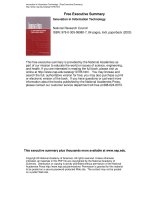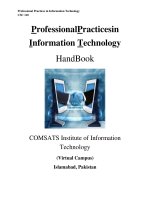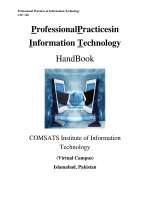Lecture Note Professional practices in information technology - Lecture No. 25: Referencing
Bạn đang xem bản rút gọn của tài liệu. Xem và tải ngay bản đầy đủ của tài liệu tại đây (286.25 KB, 5 trang )
Professional Practices in Information Technology
CSC 110
ProfessionalPracticesin
Information Technology
HandBook
COMSATS Institute of Information
Technology
(Virtual Campus)
Islamabad, Pakistan
Professional Practices in Information Technology
CSC 110
Lecture 25
Referencing
25.1 Introduction
InText Referencing Systems
In text reference e.g. Davis and McKay (1996, p.112) note that “it is important to be flexible
about the system of referencing and adopt whichever style is appropriate”.
Full reference e.g.Davis, L.B. and McKay, S. 1996, Structures and Strategies: An introduction to
Academic Writing, Macmillan Education Australia, Melbourne.
NumberNote Referencing Systems
Numbered reference Davis and McKay note that “it is important to be flexible about the system
of referencing and adopt whichever style is appropriate” [1].
Full reference: Lloyd Davis and Susan McKay, Structures and Strategies: An introduction to
Academic Writing, Macmillan Education Australia, Melbourne, 1996, p.112.
25.2 Types of Referencing
There are a few main types of referencing: Harvard (mostly used by Social Sciences, Business,
Engineering and Science), Oxford and Cambridge (mostly used in Law subjects and
occasionally referred to as 'footnoting') and APA (American Psychological Association
(Psychology and some Health Science areas) – but there are also others.
1. InText Referencing Systems
Harvard system
In text reference: Davis and McKay (1996, p.112) note that it is important to be flexible about the
system of referencing and adopt whichever style is appropriate.
Professional Practices in Information Technology
CSC 110
Full reference: Davis, L.B. and McKay, S. 1996, Structures and Strategies: An introduction to
Academic Writing, Macmillan Education Australia, Melbourne.
APA system
In text reference Davis and McKay (1996) note that it is important to be flexible about the
system of referencing and adopt whichever style is appropriate (p.112).
Full reference: Davis, L.B. & McKay, S. 1996, Structures and Strategies: An introduction to
Academic Writing, Melbourne: Macmillan Education Australia.
MLA system
In text reference: Davis and McKay note that it is important to be flexible about the system of
referencing and adopt whichever style is appropriate (112).
Full reference: Davis, Lloyd and Susan McKay. Structures and Strategies: An introduction to
Academic Writing. Melbourne: Macmillan Education Australia, 1996.
2. NumberNote Referencing Systems
OXFORD SYSTEM Numbered reference: Davis and McKay note that it is important to be
flexible about the system of referencing and adopt whichever style is appropriate [1].
Full reference: Lloyd Davis and Susan McKay, Structures and Strategies: An introduction to
Academic Writing, Macmillan Education Australia, Melbourne, 1996, p.112.
VANCOUVER SYSTEM Numbered reference: Davis and McKay note that it is importantto be
flexible about the system of referencing and adopt whichever style is appropriate1.
Full reference: Davis, L.B. & McKay, S. Structures and Strategies: An introduction to
AcademicWriting, Melbourne: Macmillan Education Australia, 1996
CAMBRIDGE FOOTNOTING REFERENCE Numbered reference: Davis and McKay note that
it is important to be flexible about the system of referencing and adopt whichever style is
Professional Practices in Information Technology
CSC 110
appropriate1.
Full reference: (appears at the bottom of the page) 1.Lloyd Davis and Susan McKay. Structures
and Strategies: An introduction to Academic Writing. Macmillan.
Harvard Referencing – Citing In Text
It is the most widely used system in business disciplines. It is the standard in La Trobe
University Business subjects. Intext references for a paraphrase* require:
1. Authors Surname (s)
2. A comma
3. Year of Publication
When you are taking notes, you should record not only the main points of the author’s work, but
also your initial critical evaluation of the material (Davis & McKay, 1996).
No author? Use the the name of the Institution eg: La Trobe University
* PARAPHRASE is when you reword the writers words (same idea but different words)
25.3 Works Cited
BOOK WITH 1 AUTHOR:
Mumford, Lewis. The Culture of Cities. New York: Harcourt, 1938. Print.
BOOK WITH 2 OR 3 AUTHORS:
Francis, R. Douglas, Richard Jones, and Donald B. Smith. Destinies: Canadian History since
Confederation. Toronto: Harcourt, 2000. Print.
BOOK WITH 4 OR MORE AUTHORS:
Baldwin, Richard et al. Economic Geography and Public Policy. Princeton: Princeton UP,
2003. Print.
TWO OR MORE BOOKS BY THE SAME AUTHOR:
Replace the author's name by three hyphens and arrange alphabetically by the book's title:
Professional Practices in Information Technology
CSC 110
Postman, Neil. Amusing Ourselves to Death: Public Discourse in the Age of Show Business.
New York: Viking, 1985. Print.
The Disappearance of Childhood. New York: Vintage, 1994. Print.
ANTHOLOGY OR COMPILATION:
Abate, Corinne S., ed. Privacy, Domesticity, and Women in Early Modern England. Burlington,
VT: Ashgate, 2003. Print.
A WORK IN AN ANTHOLOGY OR AN ESSAY IN A BOOK:
Naremore, James. "Hitchcock at the Margins of Noir." Alfred Hitchcock: Centenary Essays. Ed.
Richard Allen and S. IshiiGonzalès. London: BFI, 1999. 26377. Print.
BOOK BY A CORPORATE AUTHOR:
Associations, corporations, agencies and organizations are considered authors when there is no
single author.Organization for Economic Cooperation and Development. Action against Climate
Change: The Kyoto Protocol and Beyond. Paris: OECD, 1999. Print.
ARTICLE IN A REFERENCE BOOK OR AN ENTRY IN AN ENCYCLOPEDIA:
If the article/entry is signed, include the author's name; if unsigned, begin with the title of the
entry
Guignon, Charles B. "Existentialism." Routledge Encyclopedia of Philosophy.Ed. Edward Craig.
10 vols. London: Routledge, 1998. Print.
ARTICLE REPRINTED IN A REFERENCE BOOK ONLINE:
Carlson, Eric W. “The Range of Symbolism in Poetry.” The South Atlantic Quarterly 48.3
(1949): 44252. Rpt. in Poetry Criticism.Ed. Jane Kelly Kosek and Christine Slovey.Vol. 13.
Detroit: Gale, 1995. 8384. Literature Criticism Online.Web. 18 Oct. 2009.
A TRANSLATION:
Kafka, Franz. Metamorphosis.Trans. and Ed. Stanley Corngold. New York: Bantam, 1972. Print.
A GOVERNMENT PUBLICATION:
United Nations.Dept. of Economic and Social Affairs.Population Division.Charting the Progress
of Populations. New York: UN, 2000. Print.









